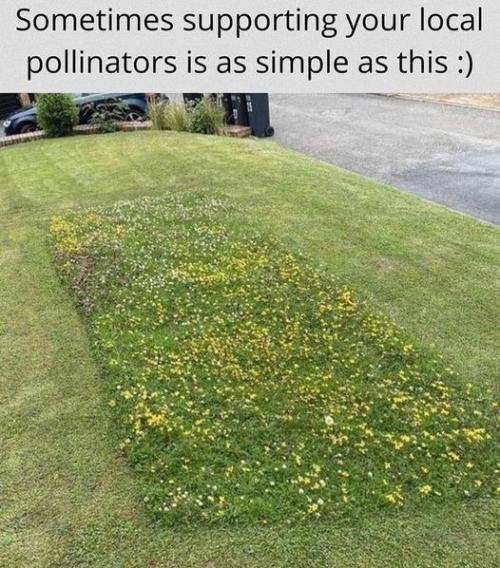Pollinator Pathways
July 11, 2023
Looking to help support native bees? A DIY bee hotel can be fun and bring more native bees to your garden. Read on to make sure it’s done right so you help, rather than hurt, the bees. Here is more on what works and on important maintenance to keep disease and parasites away from the bees.
https://xerces.org/blog/5-ways-to-increase-nesting-habitat-for-bees
https://www.gardenmyths.com/bee-hotels-really-work "
May 15, 2022
Is your spouse refusing "no-mow-May? Leave some or most of your yard alone for May. Turn a portion of it into a permanent bed for native plants. Discovering new plants is fun.

April 11, 2022
- The North Stonington Pollinator Pathway Project has successfully reached its fundraising goal! As a result or raising $630 from a crowdfunding campaign, the project will receive a match grant from Sustainable CT. These funds will help develop plantings in the public spaces on Main Street from Rocky Hollow Road past the old school property to Route 2, as well as encourage homeowners to create a continuous corridor, a healthy landscape where pollinators have a free flow to do their work for our food and flowers.
- You can still the pollinators even if your property is not along this project pathway! Just add some native plants (whether in pots or gardens) to sustain pollinators, avoid using pesticides, and learn about the best ways to maintain a healthy landscape. You can also try to incorporate blooms for the entire season. Even better, mass plantings make it easier for insects to find the plants. Be part of the Pathway movement in communities nationwide aiming to combine public and private land, giving our pollinators a chance not just to survive but to thrive.
- Did you know that you can help butterflies and other beneficial insects such as ladybugs have a better shot at life by taking some easy steps as part of your spring garden cleanup routine? Most importantly, try not to start your cleanup until daytime temperatures are consistently above 50 degrees Fahrenheit for at least 7 consecutive days. To learn more visit: https://savvygardening.com/spring-garden-clean-done-right/#:~:text=Wait%20as%20long%20as%20you,at%20least%207%20consecutive%20days.
March 3, 2022- You can help with just a few dollars. We've established an initial pathway through the Village. A matching grant through Sustainable CT will allow us to develop the public portions of the pathway. Please go to https://www.patronicity.com/nostopollinators
Pollinator Pathways aims to establish pollinator-friendly habitats and food sources for bees, butterflies, hummingbirds and other pollinating insects and wildlife.
With the Sustainability Committee, the Town of North Stonington has started a Pollinator Pathways program. More information on Pollinator Pathways can be found here as well as below: https://www.pollinator-pathway.org/
What is a Pollinator Pathway?
- pesticide-free corridors of native plants that provide nutrition and habitat for pollinators
- these protected corridors are created from a partnership of public and private properties
- even the smallest of available green spaces like flower boxes and curb strips can be part of the pathway
This Pollinator Pathway project is organized by volunteers from town conservation organizations working together to establish pollinator-friendly habitat and food sources for bees, butterflies, hummingbirds and other pollinating insects and wildlife along a series of continuous corridors. Most native bees have a range of about 750 meters, so the goal is to connect properties that are no farther apart than that. This project began in 2017 in Wilton, CT. Since then, pathways have been established in over 200 towns in CT, NY, MA, NJ, PA and the list keeps growing.
Without pollinators, we can’t feed ourselves. Pollination enables the plants in our yards, parks, farms and orchards to reproduce. Imported European honey bees are the bees we think of most often, but there are over 4000 species of bees native to the United States, and they play a vital role in pollinating the plants we rely on in our communities. Pollinator populations are in sharp decline because of pesticide use and loss of habitat. Bee populations, both native and honey bees, have seen sharp declines. Monarch butterflies have declined by 94.6% in the last 20 years, according to the US Wildlife Federation. A recent German study shows a 75% decline in all flying insects in the last 25 years. The threat to pollinators is a threat to us!
Because the Pollinator Pathway “de-fragments” the environment, it benefits our ecosystem as a whole. Our landscape has been chopped up, or fragmented, through urban- and suburban-ization. The problem is, we can no longer support sustainable populations of wildlife in our isolated parks and preserves alone, as Dr. Doug Tallamy, University of Delaware entomologist, argues so eloquently in his book Bringing Nature Home. Luckily, there is a solution. If we begin to manage our own yards organically and with native plantings, we can use them to connect parks and preserves, creating crucial corridors for wildlife. That is the idea behind the Pollinator Pathway.
Why do native plants matter? Our local pollinators have evolved to depend on our local plants. Our caterpillars and bees can’t use trees from China and Japan. The monarch butterfly is a good example as it must have the milkweed plant to survive. Without the milkweed, there will be no monarchs, and we don’t typically put these “weeds” in our yards. They have also been eradicated from fields by farmers, and now the monarch is in danger of extinction.
What to plant. Here are our favorite plant lists.

